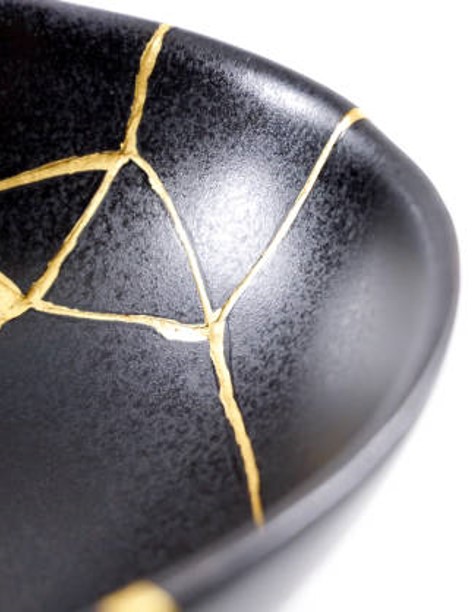The Kintsugi story: the Japanese emperor asks his master of the tea ceremony for a cup of tea. The cup or teapot breaks, and the servant is in fear of his life. But another creative person suggests this can be remedied, and painstakingly reassembles the broken pieces, fusing them together with molten gold. The emperor is delighted with this new, valuable creation. He commends the process, and the art of Kintsugi is born.
Can anyone here today claim to be perfect??
We don’t usually arrive at our mature years without many broken and re-assembled pieces, some chips off here and there – a little battle-worn.
2 Corinthians 4:7 refers to us as ‘jars of clay’ – basic, utilitarian pieces of pottery; fragile, breakable under the pressures of life. But the passage continues to state that for those of us who are Christian, those same fragile vessels also contain the most invaluable treasure, that is, the presence of Christ in the Holy Spirit.
One could almost say that the more ‘cracks’ that are visible, the more that treasure could be revealed.
The master of Kintsugi relishes the broken parts – he imagines the finished object already in his capable hands. He takes the broken pieces and carefully places them in alignment, preparing the object again to be made whole. Then he commences the process of making the precious gold which will be the means by which the pieces are fused – a painstaking, precise and exacting process.
The master does all this, NOT to fix or mend (although this is a part of the story), but because he’s CREATING something very new. And, because of the gold, far more precious.
Do you see any parallels here?
God – the master craftsman – takes the brokenness of our lives and re-creates that life – with the ‘gold’ of the blood of Jesus. He makes us whole – a new creation – by the blood of Christ.
Our brokenness – once made new in Christ – becomes our testimony to the grace of God in our lives. Our scars become evidence of Jesus’ ongoing work in our lives; our sanctification if you like.
Jesus himself was totally broken; he was made new, resurrected. But what was the evidence of this to doubting Thomas in particular? His scars!
Back to our story: the emperor was so impressed with the craftsman’s work – it was so much more valuable to him because of the ‘repairs’. It’s ‘imperfections’ made it perfect in his eyes.
We are more precious in the eyes of God when we take the broken pieces of our lives to him and allow his bounteous grace to heal us and to transform and renew us.
I sometimes wonder if this is not analogous to the concept of ‘truth telling’ our indigenous brothers and sisters are asking for. Recognising the wrongs, the pain – the brokenness – and as we know, taking them to Jesus to heal and make new. Our world is broken too – could God be asking us to admit our need of restoration, and would our going to him with the broken pieces be the repentance required before making it anew?
So, be encouraged, church. Our ‘chips’, our cracks and wounds are the very things which the Master Creator can take and use to renew us, and so, to reflect his glory. He alone imagines the finished product and will one day hold it in his hands and proclaim: ‘this is very, very good’!

